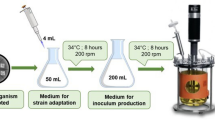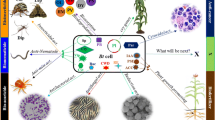Abstract
Chitinases play an important role in the degradation of the cuticular chitin during the process of ecdysis. In this study, we compared the chitinases of two insect species, Bombyx mori (silkworm) and Helicoverpa armigera (bollworm), to assess the relation between characteristics and chitinase patterns. Differences between two chitinases were observed after purification using ammonium sulfate precipitation, affinity chromatography, and sodium dodecyl sulfate–polyacrylamide gel electrophoresis (SDS-PAGE) assay. Although the specific activities of the purified enzymes were different, the purification yields were similar. One band of 88 kDa was observed for B. mori, and the other band of 75 kDa was detected for H. armigera. When a range of properties was tested, it was found that the optimum temperatures of B. mori and H. armigera chitinases were 45 and 50°C, respectively; the optimum pH value was 6.0 for both chitinases. Mn2+ played catalytic role while Cu2+ and SDS strongly inhibited activities of both enzymes. Between two chitinases, differences in K M were also observed. K M of chitinase from silkworm and bollworm was found to be 22.3 and 41.0 μmol/l, respectively. Both the chitinases significantly inhibited the spore germination of two fungal species, Saccharomyces cerevisiae and Penicillium.







Similar content being viewed by others
References
Molinari, L. M., Pedroso, R. B., Scoaris Dde, O., Ueda-Nakamura, T., Nakamura, C. V., & Dias Filho, B. P. (2007). Identification and partial characterisation of a chitinase from Nile tilapia, Oreochromis niloticus. Comparative Biochemistry and Physiology, Part B., Biochemistry & Molecular Biology, 146, 81–87.
Fukamizo, T., & Kramer, K. J. (1985). Mechanism of chitin hydrolysis by the binary chitinase system in insect moulting fluid. Insect Biochemistry, 15, 141–145.
Fukamizo, T., & Kramer, K. J. (1987). Effect of 20-hydroxyecdysone on chitinase and β-N-acetylglucosaminidase during the larval-pupal transformation of Manduca sexta (L.). Insect Biochemistry, 17, 547–550.
Kramer, K. J., & Muthukrisshnan, S. (1998). Insect chitinases: molecular biology and potential use as biopesticides. Insect Biochemistry and Molecular Biology, 11, 887–900.
Wang, X. R., Ding, X. F., Gopalakrishnan, B., et al. (1996). Characterization of a 46 kDa insect chitinase from transgenic tobacco. Insect Biochemistry and Molecular Biology, 10, 1055–1064.
Flach, J., Pilet, P. E., & Jolles, P. (1992). What’s new in chitinase research? Experientia, 48, 70l–716.
Merzendorfer, H., & Zimoch, L. (2003). Chitin metabolism in insects: structure, function and regulation of chitin synthases and chitinases. Journal of Experimental Biology, 206, 4393–4412.
Gooday, G. W. (1997). The ever-widening diversity of chitinase. Carbohydrates in Europe, 19, 18–22.
Babiker, M. A., Banat, Y. K., Kameyama, Y., Yoshioka, T., & Koga, D. (1999). Purification and characterization of a 54 kDa chitinase from Bombyx mori. Insect Biochemistry and Molecular Biology, 29, 537–547.
Kabir, K. E., Hirowatari, D., Watanabe, K., & Koga, D. (2006). Purification and characterization of a novel isozyme of chitinase from Bombyx mori. Bioscience, Biotechnology, and Biochemistry, 70, 252–262.
Driss, F., Kallassy-Awad, M., Zouari, N., & Jaoua, S. (2005). Molecular characterization of a novel chitinase from Bacillus thuringiensis subsp. kurstaki. Journal of Applied Microbiology, 99, 945–953.
Kuranda, M. J., & Robbins, P. W. (1991). Chitinase is required for cell separation during growth of Saccharomyces cerevisiae. The Journal of Biological Chemistry, 266, 19758–19767.
Lee, Y. G., Chung, K.-C., Wi, S. G., Lee, J. C., & Bae, H.-J. (2009). Purification and properties of a chitinase from Penicillium sp. LYG 0704. Protein Expression and Purification, 65, 244–250.
Fukamizo, T., Koga, D., & Goto, S. (1995). Comparative biochemistry of chitinases: Anomeric form of the reaction products. Bioscience, Biotechnology, and Biochemistry, 59, 311–313.
Hollis, T., Monzingo, A. F., Bortone, K., Ernst, S., Cox, R., & Robertus, J. D. (2000). The X-ray structure of a chitinase from the pathogenic fungus Coccidioides immitis. Protein Science, 9, 544–551.
Liu, D., Cai, J., Xie, C. C., Liu, C., & Chen, Y.-H. (2010). Purification and partial characterization of a 36-kDa chitinase from Bacillus thuringiensis subsp. colmeri, and its biocontrol potential. Enzyme and Microbial Technology, 46, 252–256.
Nguyen, N. V., Kim, Y. J., Oh, K. T., Jung, W. J., & Park, R. D. (2008). Antifungal activity of chitinases from Trichoderma aureoviride DY-59 and Rhizopus microsporus VS-9. Current Microbiology, 56, 28–32.
Yamamoto, Y., Fukunaga, Y., Aoyagi, H., & Tanaka, H. (1995). Purification and characterisation of chitinase secreted by cultured Wasabia japonica cells. Journal of Fermentation and Bioengineering, 80, 148–152.
Patel, A. K., Singh, V. K., Yadav, R. P., Moir, A. J. G., & Jagannadham, M. V. (2010). Purification and characterization of a new chitinase from latex of Ipomoea carnea. Process Biochemistry, 45, 675–681.
Schnitzhofer, W., Weber, H. J., Vrsanska, M., Biely, P., Cavaco-Paulo, A., & Guebitz, G. M. (2007). Purification and mechanistic characterisation of two polygalacturonases from Sclerotium rolfsii. Enzyme and Microbial Technology, 40, 1739–1747.
Lowry, O. H., Rosenbrough, N. J., Farr, A. L., & Randall, R. J. (1951). Protein measurement with the folin phenol reagent. The Journal of Biological Chemistry, 193, 265–275.
Kramer, K. J., & Koga, D. (1986). Insect chitin: physical state, synthesis, degradation and metabolic regulation. Insect Biochemistry, 16, 851–877.
Koga, D., Funakoshi, T., Mizuki, K., et al. (1992). Immunoblot analysis of chitinolytic enzymes in integument and molting fluid of the silk worm, Bombyx mori, and the tobacco hornworm, Manduca sexta. Insect Biochemistry and Molecular Biology, 22, 305–311.
Krishnan, A., Nair, P. N., & Jones, D. (1994). Isolation, cloning and characterization of a new chitinase stored in active form in chitinlined venom reservoir. The Journal of Biological Chemistry, 269, 20971–20976.
Crispinus, A. O., Naoto, Y., & Kihachiro, O. (2001). Purification and characterization of a chitinase from Trichoderma viride. The Journal of General and Applied Microbiology, 47, 53–61.
Itoh, Y., Kawase, T., & Nikaidou, N. (2002). Functional analysis of the chitin-binding domain of a family 19 Chitinase from Streptomyces griseus HUT6037: Substrate-binding affinity and cis-dominant increase of antifungal function. Bioscience, Biotechnology, and Biochemistry, 66, 1084–1092.
Ulrike, R., Henning, S., & Nicole, G. (2004). Expression, purification and characterization of recombinant sucrose synthase 1 from Solanum tuberosum (L.). for carbohydrate engineering. Journal of Biotechnology, 107, 135–149.
Ye, X. Y., & Tzi Bun, Ng. (2005). A chitinase with antifungal activity from the mung bean. Protein Expression and Purification, 40, 230–236.
Singh, A., Kirubakaran, S. I., & Sakthivel, N. (2007). Heterologous expression of a new antifungal chitinase from wheat. Protein Expression and Purification, 56, 100–109.
Acknowledgments
This study was supported by the International Science & Technology Cooperation Plan of Anhui Province (Grant # 08080703017) and National Innovative Experimental Design of Hefei University of Technology (Grant # 091035945). The authors thank Professors Hiroshi Tomota of the Kitasato University, Tokyo and Fusheng Chen of the Institute of Sericulture, Anhui Academy of Agricultural Sciences, Anhui for their valuable help and support.
Author information
Authors and Affiliations
Corresponding author
Rights and permissions
About this article
Cite this article
Zhang, H., Liu, M., Tian, Y. et al. Comparative Characterization of Chitinases from Silkworm (Bombyx mori) and Bollworm (Helicoverpa armigera). Cell Biochem Biophys 61, 267–275 (2011). https://doi.org/10.1007/s12013-011-9196-2
Published:
Issue Date:
DOI: https://doi.org/10.1007/s12013-011-9196-2




